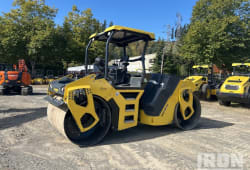Marketing Tips for Used Heavy Equipment: Reach the Right Buyers
13 Min read
)
August 11, 2023
In the competitive world of used heavy equipment, having effective marketing strategies is essential to reach the right buyers. Understanding the used heavy equipment market and developing a comprehensive marketing strategy is key to gaining a competitive edge. In this article, we will explore various marketing channels, leveraging online platforms for sales, building strong customer relationships, case studies of successful strategies, and future trends in used heavy equipment marketing.
Understanding the Used Heavy Equipment Market
The used heavy equipment market is a dynamic industry that plays a crucial role in various sectors, from construction to mining. It is a vast and complex market that requires a deep understanding of its trends, key players, and challenges to formulate effective marketing strategies.
When it comes to the key players in the used heavy equipment market, several dominant figures shape the industry. These players include manufacturers, dealers, rental companies, and auction houses. Each of these entities plays a unique role in the market, and understanding their positions and market share can help you identify potential partnerships or competitors.
Manufacturers, for instance, are responsible for producing heavy equipment that meets the demands of various industries. They invest heavily in research and development to create innovative and efficient machinery. Dealers, on the other hand, act as intermediaries between manufacturers and end-users. They play a crucial role in marketing and distributing used heavy equipment, providing after-sales services, and building customer relationships.
Rental companies are another important player in the used heavy equipment market. They offer a cost-effective solution for businesses that require heavy equipment temporarily. By renting equipment, companies can avoid the high upfront costs of purchasing new machinery. Auction houses, on the other hand, provide a platform for buying and selling used heavy equipment through competitive bidding.
Understanding the roles and market share of these key players is essential for developing effective marketing strategies. By identifying potential partners or competitors, you can leverage their strengths and weaknesses to gain a competitive advantage in the market.
Current trends and challenges also greatly influence the used heavy equipment market. Staying up to date with these factors is crucial for adapting your marketing strategies to stay ahead of the competition.
One of the notable trends in the market is the increasing demand for refurbished equipment. As businesses aim to reduce costs and maximize their investments, refurbished equipment offers a more affordable alternative to new machinery. This trend presents opportunities for innovative marketing approaches, such as highlighting the cost savings and environmental benefits of purchasing refurbished equipment.
Another trend that has shaped the used heavy equipment market is the rise of online marketplaces. With the advent of technology, buyers and sellers can now connect and transact through online platforms, expanding their reach beyond geographical limitations. This trend has revolutionized the way used heavy equipment is bought and sold, providing convenience and accessibility to both buyers and sellers.
However, along with these trends come challenges that need to be addressed. Competition is fierce in the used heavy equipment market, with numerous players vying for a share of the market. It is important to differentiate your products and services from competitors to attract customers and build brand loyalty.
Price volatility is another challenge that affects the used heavy equipment market. The prices of used equipment can fluctuate due to various factors, such as supply and demand dynamics, economic conditions, and market trends. Adapting to these price fluctuations and offering competitive pricing strategies is crucial to remain profitable in the market.
Furthermore, customer demands in the used heavy equipment market are constantly changing. Businesses are looking for equipment that not only meets their operational needs but also aligns with their sustainability goals. Understanding and catering to these evolving customer demands is essential for success in the market.
In conclusion, the used heavy equipment market is a complex and ever-evolving industry. By understanding the key players, current trends, and challenges, you can develop effective marketing strategies that enable you to navigate this dynamic market successfully.
Developing a Comprehensive Marketing Strategy
When it comes to marketing used heavy equipment, a comprehensive strategy is essential for reaching the right buyers. This section explores key elements that should be considered in your marketing approach.
In today's competitive market, it is crucial to have a well-defined marketing strategy that sets you apart from your competitors. By developing a comprehensive marketing plan, you can effectively promote your used heavy equipment and attract potential buyers.
Identifying Your Target Audience
Understanding your target audience is essential for effective marketing. Different segments within the used heavy equipment market have distinct needs and preferences. By identifying your audience, you can tailor your marketing messages and channels to resonate with them.
For instance, if your target audience consists of construction companies, you can focus your marketing efforts on highlighting the durability, reliability, and cost-effectiveness of your used heavy equipment. On the other hand, if your target audience comprises agricultural businesses, you can emphasize the efficiency, versatility, and low maintenance of your equipment.
Furthermore, by conducting thorough market research, you can gain insights into your target audience's buying behaviors and preferences. This knowledge can help you refine your marketing strategy and develop compelling campaigns that capture their attention.
Setting Clear Marketing Goals
Setting clear marketing goals helps you stay focused and measure your success. Whether your goal is to increase sales by a certain percentage or expand into new markets, having specific goals allows you to align your marketing efforts toward achieving them.
When setting your marketing goals, it is important to ensure they are SMART (Specific, Measurable, Achievable, Relevant, and Time-bound). For example, instead of setting a vague goal like "increase sales," you can set a specific goal such as "increase sales by 20% within the next six months by targeting new industries and improving customer retention."
By setting clear goals, you can track your progress, identify areas for improvement, and make informed decisions to optimize your marketing strategies. Additionally, having measurable goals allows you to determine the return on investment (ROI) of your marketing efforts and make data-driven adjustments as needed.
In conclusion, developing a comprehensive marketing strategy for promoting used heavy equipment involves understanding your target audience and setting clear goals. By tailoring your marketing messages and channels to resonate with your audience and setting specific goals, you can effectively reach potential buyers and achieve success in the competitive market.
Effective Marketing Channels for Used Heavy Equipment
Choosing the right marketing channels is crucial for reaching your target audience. This section explores both traditional and digital marketing channels that can be effective in promoting used heavy equipment.
When it comes to marketing using heavy equipment, it's important to consider a variety of channels to ensure maximum visibility and engagement. Let's dive deeper into the traditional and digital marketing channels that can help you connect with potential buyers and drive sales.
Traditional Marketing Channels
While digital marketing has gained significant traction in recent years, traditional marketing channels still hold their ground when it comes to promoting used heavy equipment.
Trade shows continue to be a popular avenue for businesses looking to showcase their products and connect with industry professionals. These events offer a unique opportunity for face-to-face interactions, allowing potential buyers to see the equipment up close and ask questions directly to the sellers.
In addition to trade shows, print advertisements in industry-specific publications can be an effective way to reach a targeted audience. These publications often have a loyal readership within the heavy equipment industry, ensuring that your advertisement is seen by individuals who are actively interested in purchasing used equipment.
Furthermore, industry publications provide tangible marketing materials that potential buyers can refer back to when making purchasing decisions. From glossy brochures to informative catalogs, these materials can leave a lasting impression and serve as a valuable resource for buyers.
Digital Marketing Channels
In today's digital age, digital marketing channels have become essential for reaching a wider audience and maximizing your marketing efforts.
A well-designed website is a fundamental component of any digital marketing strategy. It serves as a virtual storefront, showcasing your inventory and providing detailed information about the used heavy equipment you have available. A user-friendly website with clear navigation and high-quality visuals can significantly enhance the user experience and increase the likelihood of conversions.
Search engine optimization (SEO) is another crucial aspect of digital marketing. By optimizing your website's content and structure, you can improve your visibility in search engine results and attract organic traffic from individuals actively searching for used heavy equipment.
Email marketing is a powerful tool for nurturing leads and maintaining relationships with potential buyers. By capturing email addresses through website sign-ups or trade show interactions, you can send targeted emails with updates on new arrivals, special promotions, and industry insights. This personalized approach can help keep your business top-of-mind and increase the likelihood of conversions.
Lastly, paid online advertising, such as Google Ads or social media advertising, allows you to reach specific demographics and target individuals who are actively searching for or interested in heavy equipment. With advanced targeting options, you can tailor your ads to reach the right people at the right time, maximizing your return on investment.
Monitoring the effectiveness of your marketing efforts is crucial for making data-driven decisions and optimizing your strategies. By utilizing analytics tools, you can track website traffic, email open rates, click-through rates, and other key metrics to gain insights into what is working and what can be improved.
By leveraging both traditional and digital marketing channels, you can create a comprehensive marketing strategy that reaches a wide range of potential buyers. Remember, the key is to adapt and evolve your marketing efforts based on the ever-changing landscape of the heavy equipment industry and the preferences of your target audience.
Leveraging Online Platforms for Sales
Online platforms have revolutionized the way used heavy equipment is bought and sold. This section explores the benefits of utilizing online marketplaces and social media marketing for reaching potential buyers.
When it comes to selling used heavy equipment, online marketplaces have become an indispensable tool for businesses. Gone are the days of relying solely on local classified ads or word-of-mouth referrals. With online marketplaces, sellers now have a centralized platform to connect with buyers from all over the world.
One of the key benefits of online marketplaces is the convenience they offer. Instead of spending time and resources on traditional marketing methods, sellers can simply create a listing on a reputable online marketplace and reach a wide audience with just a few clicks. This convenience not only saves sellers time and money but also allows them to focus on other important aspects of their business.
Another advantage of utilizing online marketplaces is the wider reach they provide. With a global audience at their fingertips, sellers can expand their customer base beyond their local market. This means that even if there is limited demand for used heavy equipment in their area, they can still find potential buyers from other parts of the world who are actively looking for the equipment they have to offer.
Furthermore, online marketplaces allow sellers to showcase their equipment in a way that traditional methods cannot. By creating detailed listings with high-quality photos and accurate descriptions, sellers can provide potential buyers with a comprehensive view of the equipment. This not only helps buyers make informed decisions but also increases the chances of attracting serious inquiries.
Benefits of Online Marketplaces:
- Convenience and time-saving
- Wider reach and global audience
- Detailed listings with high-quality photos and accurate descriptions
- Increased chances of attracting potential buyers
While online marketplaces are undoubtedly powerful tools for selling used heavy equipment, social media platforms have also emerged as valuable channels for reaching potential buyers. Platforms such as Facebook, Instagram, and LinkedIn offer a range of tools and features that can be leveraged for effective marketing.
One of the key advantages of using social media for marketing is the ability to create engaging content. By sharing informative and visually appealing posts about their equipment, sellers can capture the attention of their target audience and generate interest in their offerings. Whether it's showcasing the features of a powerful excavator or highlighting the durability of a bulldozer, social media allows sellers to tell their equipment's story in a captivating way.
In addition to creating engaging content, sellers can also leverage influencer partnerships to expand their reach. Collaborating with industry influencers who have a large following can help sellers tap into new audiences and gain credibility. Whether it's through sponsored posts, product reviews, or live demonstrations, influencers can help sellers establish trust and generate leads.
Furthermore, social media platforms offer paid advertising options that can be highly targeted. Sellers can define their target audience based on factors such as location, industry, job title, and interests. This level of precision targeting ensures that sellers' marketing efforts are reaching the right people who are most likely to be interested in their equipment. By investing in paid advertising, sellers can increase their visibility and maximize their chances of generating qualified leads.
Social Media Marketing for Used Heavy Equipment:
- Creating engaging content to capture the audience's attention
- Leveraging influencer partnerships to expand reach and gain credibility
- Utilizing paid advertising for precise tarthe getting and increased visibility
Building Strong Customer Relationships
Establishing strong customer relationships is essential for repeat business and word-of-mouth referrals. This section explores the importance of after-sales service and customer retention strategies.
Importance of After-Sales Service
Providing excellent after-sales service can differentiate your business from competitors. Timely maintenance, prompt responses to inquiries, and warranty offerings build trust and enhance customer satisfaction, increasing the likelihood of repeat purchases and positive reviews.
Customer Retention Strategies
Implementing customer retention strategies can help you retain existing customers and encourage repeat business. Strategies such as loyalty programs, personalized communication, and regular updates about new equipment offerings can keep your customers engaged and loyal to your brand.
Case Studies of Successful Marketing Strategies
Examining real-world case studies can provide valuable insights into successful marketing strategies. This section showcases two examples of companies that have effectively marketed used heavy equipment to reach the right buyers.
Case Study 1
Company X, a leading heavy equipment dealer, implemented a targeted email marketing campaign to reach potential buyers within a specific industry. By tailoring their message and offering personalized promotions, Company X was able to generate a significant increase in sales and expand their customer base.
Case Study 2
Company Y, an online marketplace specializing in used heavy equipment, utilized social media platforms to reach a wide audience of potential buyers. By collaborating with industry influencers and showcasing customer testimonials, Company Y was able to establish credibility and generate a high volume of inquiries and sales.
Future Trends in Used Heavy Equipment Marketing
Keeping up with industry trends and adopting forward-thinking marketing practices is crucial for long-term success. This section explores the impact of technology on marketing strategies and sustainable marketing practices for used heavy equipment.
Impact of Technology on Marketing Strategies
Advancements in technology continue to shape marketing strategies in the used heavy equipment industry. Robotics, artificial intelligence, and virtual reality have the potential to revolutionize the way equipment is marketed and demonstrated. Staying abreast of these developments can provide a competitive advantage.
Sustainable Marketing Practices for Used Heavy Equipment
Sustainable marketing practices not only benefit the environment but also resonate with customers who value environmentally responsible businesses. Emphasizing the durability and energy efficiency of used heavy equipment, as well as offering recycling programs, can showcase your commitment to sustainability.
In conclusion, effective marketing strategies are essential for reaching the right buyers in the used heavy equipment market. Understanding the market, developing a comprehensive strategy, utilizing effective marketing channels, leveraging online platforms, building strong customer relationships, and staying informed about future trends can help you stay ahead of the competition and maximize your sales potential.














